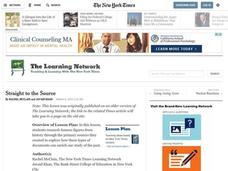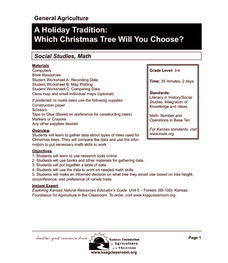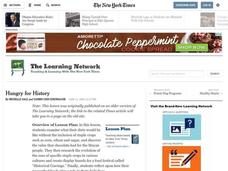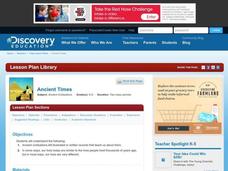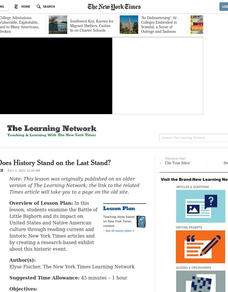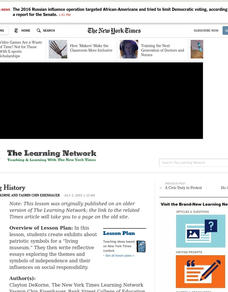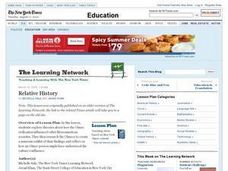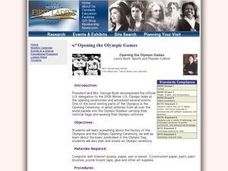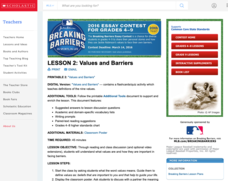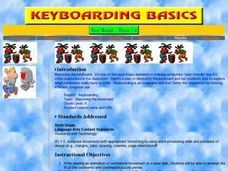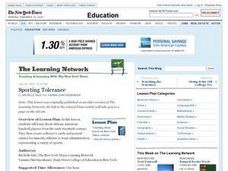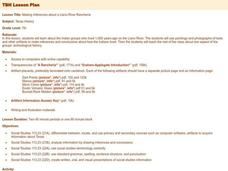Curated OER
Straight to the Source
Research famous figures from history through the primary sources they created! Explore how these types of documents can enrich our study of the past with your middle and high school learners. They create picture books to illustrate...
Curated OER
Hamilton and Burr : Compare and Contrast
Who were Aaron Burr and Alexander Hamilton? High schoolers examine the character traits of these historical figures and watch the video, The Duel. Hamilton vs. Burr: An Event that Changed History (available from PBS), to gain...
Agriculture in the Classroom
A Holiday Tradition: Which Christmas Tree Will You Choose?
Different varieties of Christmas trees provide an interesting way to combine social studies, science, math, and technology. Class members not only research the history of the Christmas tree holiday tradition, they compare and...
Curated OER
Medieval Times: Castles, Knights, and Heraldry
Students demonstrate the ability to use the computers for research and exploration of castles and any other sources needed and locate web sites for various needs. They explain what a coat of arms was and make their own .
Curated OER
Front Page History
Learners consider how current events are directly and intricately tied to past events, decisions and other influences. The island of Guam is used as a case study as the events of WWII have continued to affect the people of Guam today.
Curated OER
Word Up!
Study the importance of word choice in informational text. Middle and high schoolers locate unfamiliar words and phrases in newspaper articles of their choosing, and use online word sites to explore the definitions and histories of each....
LABScI
Harmonic Motion: Pendulum Lab
Several times throughout history, groups of soldiers marching in rhythm across a suspension bridge have caused it to collapse. Scholars experiment with pendulums, resonance, and force to determine why this would happen. First, pupils...
Curated OER
Hungry for History
Students examine what their diets would be like without the inclusion of staple crops such as corn, wheat and sugar, and discover the value that chocolate had for the Mayan people. They create display boards for a food festival.
Curated OER
Consuming History
Students research various foods as well as indigenous plants and animals from different historical eras around the world. They use their research to create a design for theme restaurants.
Curated OER
Mesoamerica: The History of Central America
Young scholars research the life of a powerful woman of the Maya Empire. They analyze the role of women in Maya society and compare them to powerful women of today in an essay.
Curated OER
Ancient Times
Students create a mural depicting modern life. In this ancient civilizations lesson, students view images of wall painting from ancient civilizations showing aspects of their daily life. Students discuss the ways our life today is...
Curated OER
Forest History for Kids
Students explore the Forest and the vocabulary associated with it. In this Forest lesson plan, students take the roles of photographer and reporter to examine an area of land for evidence of past life. Students take a close-up and...
Curated OER
Whitewashing History
Students revisit issues of civil rights in the U.S. They use the recent national discussion of retiring Senator Strom Thurmond's 1948 Dixiecrat Presidential campaign as a starting point.
Curated OER
Where Does History Stand on the Last Stand?
Students examine the Battle of Little Bighorn and its impact on United States and Native American culture through reading current and historic New York Times articles and by creating a research-based exhibit about this historic event.
Curated OER
Sparking History
Students create exhibits about patriotic symbols for a living museum. They write reflective essays exploring the themes and symbols of independence and their influences on social responsibility.
Curated OER
Relative History
Students explore theories about how the Olmec civilization influenced other Mesoamerican societies. They research the Olmecs to create a museum exhibit of their findings and reflect on how an Olmec person might have understood the...
Curated OER
Las Misiones de California
Fourth graders work in partners to complete a series of activities. After reading the introduction, Students select a role of either a "Padre" or "Indigena." As partners, they need time on the computer for research as well as time to...
National First Ladies' Library
Opening the Olympic Games
Learners examine the history of the Olympic Games, including the opening ceremonies. In small groups, they create Olympic flags using symbols that represent their country and communities. In phase two of the instructional activity,...
Scholastic
Lesson 2: Values and Barriers
Scholars investigate and discuss the importance of values and how they can be used to break barriers. Small groups work collaboratively to examine the text and draw inferences to answer questions. A writing assignment challenges pupils...
Elizabeth Murray Project
Gender and Opportunity in Colonial America
What was life like for women in Colonial America? What restrictions were placed upon them and what opportunities were they afforded? A case study of Elizabeth Murray offers high schoolers a chance to investigate primary source...
Curated OER
Mastering the Keyboard
Sixth graders view an animated program showing how the continents fit together millions of years ago. In groups, they compare and contrast the distribution of rocks and fossils based on how the continents fit together. After reading a...
Curated OER
Sporting Tolerance
Students investigate African-American baseball players from the early 20th century. They read an article, answer discussion questions, write a journal entry, and create a poster-size baseball card for an athlete.
Curated OER
Making Inferences about a Llano River Rancheria
Seventh graders study the Indian groups who lived 1,000 years ago on the Llano River. They use paintings and photographs of tools and other artifacts to make inferences and conclusions about how the Indians lived.
Curated OER
Lewis and Clark and Native Americans, Part II
Young scholars research the Native Americans living in the regions explored by Lewis and Clark. They identify the modern-day names of sites claimed by the Lakota Indians, and create a poster of the original Native American names.
